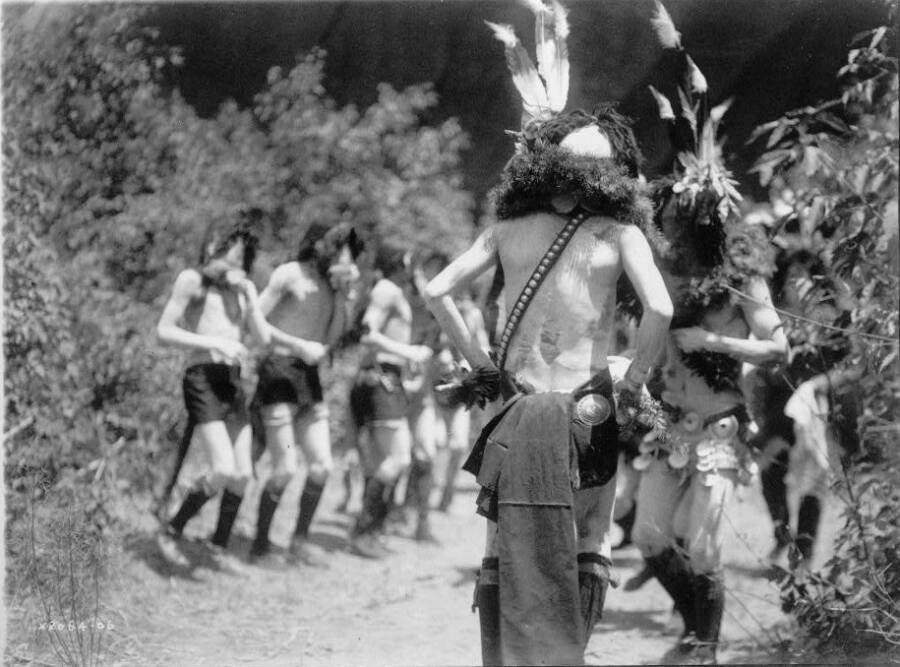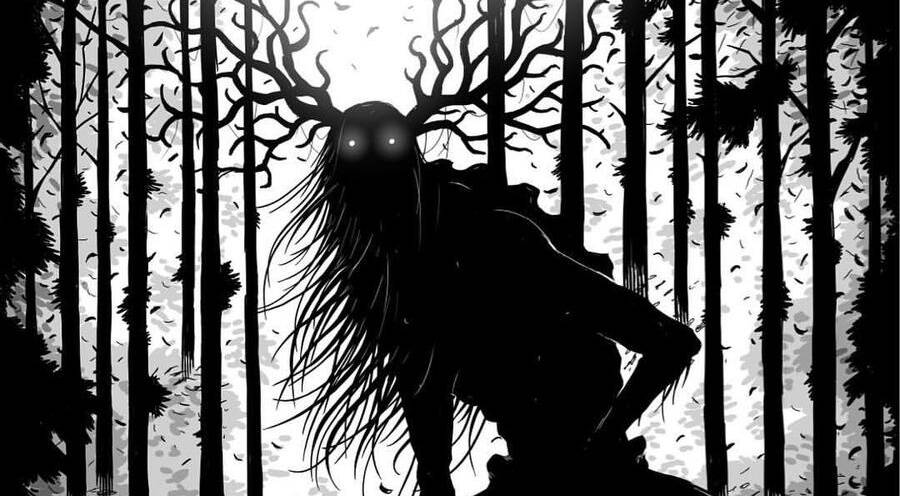From the roaming spirits of cannibalistic hunters to shapeshifting monsters, learn about some of the scariest creatures of Native American legend.

Edward S. Curtis/Library of CongressA group of Navajo men dressed as mythical characters for a ceremonial dance.
Native American folklore, like many oral traditions around the world, is rife with captivating tales passed down through the generations. Among these stories, you’ll find terrifying tales of Native American monsters that are distinct to the many tribes that inhabit the Americas.
Some legends may be familiar thanks to depictions in mainstream popular culture, though these portrayals often stray far from their Indigenous roots.
Take the Wendigo, for example.
This giant, skeletal beast from the Algonquin-speaking tribes of North America stalks the woods at night during the cold winter, searching for human flesh to devour. The Wendigo most notably inspired Stephen King’s novel Pet Sematary, but the old Indigenous tales of this creature are far scarier.
And, of course, there are monsters from Native American folklore that you’ve probably never heard of, like the legend of the Skadegamutc, also known as a ghost witch. These evil sorcerers are said to rise from the dead to hunt the living.
While these creatures have distinctly native origins, some have characteristics that are similar to monsters from European lore. For example, the only way to kill the Skadegamutc is to burn it with fire — a common weapon used to fight witches in other cultures.
So, while each of these disturbing Native American monster tales holds its own cultural significance, they also contain common threads representing the shared vulnerabilities of the human experience. And what’s more, they’re all absolutely terrifying.
The Eternally-Hungry Cannibal Monster, The Wendigo

JoseRealArt/Deviant ArtThe myth of the Wendigo, a cannibalistic man-beast that lurks in the northern forests during winter, has been told over centuries.
Among the most feared and well-known of the Native American monsters is the insatiable Wendigo. TV fans may have seen depictions of the man-eating monster in popular shows like Supernatural and Grimm. It has also been namechecked in books such as Margaret Atwood’s Oryx and Crake and Stephen King’s Pet Sematary.
Generally described as an ice-covered cannibalistic “man-beast,” the Wendigo (also spelled Windigo, Weendigo, or Windago) legend comes from the Algonquin-speaking tribes North America, which includes nations such as the Pequot, Narragansett, and Wampanoag of New England.
The story of the Wendigo is also found in the folklore of the First Nations of Canada, such as the Ojibwe/Chippewa, Potawatomi, and Cree.
Some tribal cultures describe the Wendigo as a pure evil force comparable to the boogeyman. Others say the Wendigo beast is actually a possessed human who was taken over by evil spirits as punishment for committing misdeeds such as selfishness, gluttony, or cannibalism. Once a troublesome human is turned into a Wendigo, little can be done to save them.
According to Native American folklore, the Wendigo stalks the woods during dark winter nights looking for human flesh to devour and luring victims with its eerie ability to mimic human voices. Disappearances of tribal members or other forest inhabitants were often attributed to the doings of the Wendigo.
The physical appearance of this monstrous beast differs between legends. Most describe the Wendigo as a figure about 15 feet tall with an emaciated, haggard body, signifying its insatiable appetite for feeding on human flesh.
In his book The Manitous, First Nation Canadian author and scholar Basil Johnston described the Wendigo as a “gaunt skeleton” that gave off “a strange and eerie odor of decay and decomposition, of death and corruption.”
The legend of the Wendigo has been passed down through generations of tribes. One of the most popular versions of this myth tells the story of a Wendigo monster that was defeated by a little girl who boiled tallow and threw it all over the creature, making it small and vulnerable to attack.
While the vast majority of alleged Wendigo sightings occurred between the 1800s and 1920s, claims of the flesh-eating monster man still surface around the Great Lakes territory every so often. In 2019, mysterious howls allegedly heard by hikers in the Canadian wilderness led to suspicions that the horrific sounds were caused by the infamous man-beast.
Scholars believe that this Native American monster is a manifestation of real-world problems like starvation and violence. Its link to the possession of a sinful human may also symbolize how these communities perceive certain taboos or negative behavior.
One clear thing is that these monsters can take different shapes and forms. As some Native American myths suggest, there are certain lines that people may cross that can turn them into a hideous being. As Johnston wrote, “turning Wendigo” can become an ugly reality when one resorts to destruction in the face of adversity.





